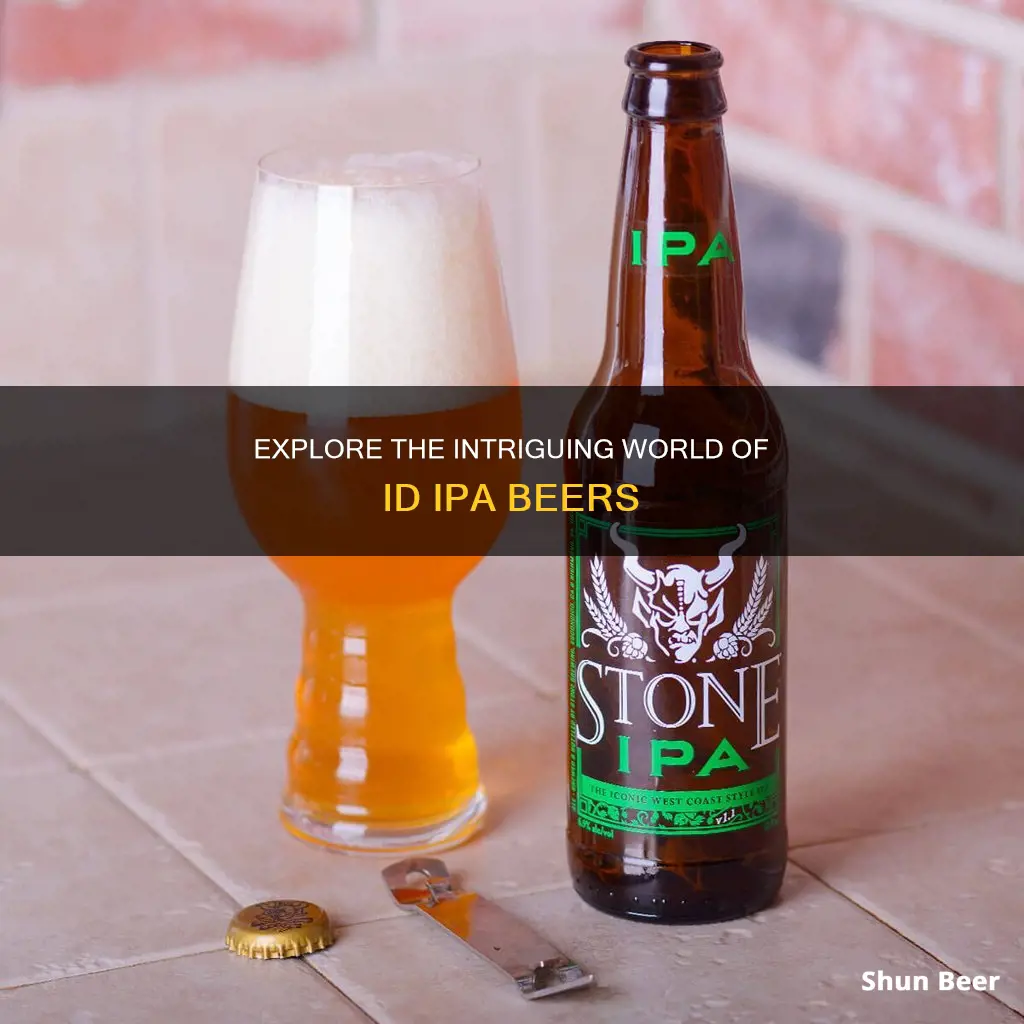
India Pale Ale, or IPA, is a hoppy beer style within the broader category of pale ale. The name dates back to the British Empire and their colonies. British sailors and soldiers sought a beer recipe that would be easy to preserve on long trips from Britain to India. Thus, the India Pale Ale was born. The IPA has come a long way since colonial times, but the hoppy quality has mostly remained the same. Today, IPAs are best enjoyed fresh and cold.
| Characteristics | Values |
|---|---|
| Full Form | India Pale Ale or Indian Pale Ale |
| Origin | Britain |
| History | Developed in the 1780s to be exported to India, which was under the control of the British East India Company |
| Flavour | Stronger and hoppier than regular beer |
| Alcohol Content | Varies, but generally higher than average |
| Types | Session IPA, West Coast IPA, New England IPA, Double IPA, Triple IPA, Black IPA, Brut IPA, etc. |
| Serving Temperature | Fresh, cold |

History of IPAs
The India Pale Ale (IPA) was allegedly invented by the British during their colonisation of India. The beer they sent to their troops kept spoiling during the long sea voyage around the Cape of Africa. Extreme temperatures and prolonged storage without refrigeration were less than ideal for transporting beer. The British hit upon a solution: alcohol and hops, which act as preservatives.
According to legend, the first IPA was created by George Hodgson of East London's Bow Brewery. It was bitter and highly alcoholic, but it could make the long ocean trip. Hodgson's beer was imitated by bigger brewers, such as Bass, and it evolved into something weaker, just plain old pale ale, for the home market.
The first known recorded mention of the phrase "India Pale Ale" came in 1835 in an edition of the Liverpool Mercury. By the 1860s, IPAs were widely brewed in England and they were much more attenuated and hopped than porters and ales. Demand for the export style of pale ale developed in England around 1840, and IPA became a popular product there.
In the late 20th century, craft beer revolutionised the United States, and brewers began seeking out old beer styles that had fallen out of fashion. The traditional IPA style was well-suited to modelling the intense flavour and aroma of American hops. The popularity of IPAs has since spread across the world.
Guinness' Surprising Health Benefits Over Other Beers
You may want to see also

IPA meaning
India Pale Ale, or IPA, is a hoppy beer style within the broader category of pale ale. It is one of the most influential beer styles of the last few decades, with a history dating back to the days of British global dominance.
The name, India Pale Ale, refers to the beer's origins as an export beer shipped from Britain to India during the period of colonial rule. The beer was first brewed in the UK in the 1780s and became popular among British soldiers and administrators serving in India, which was then under the control of the British East India Company.
The IPA was originally developed to withstand long voyages by sea. The beer was brewed with lots of hops, which acted as a preservative, ensuring the beer remained drinkable after the long journey from Britain to India. The high alcohol content also helped to preserve the beer.
Today, IPAs are known for their bold, bitter, and fruity flavours, with a strong emphasis on the hoppy character. While the traditional British IPA tends to be very hoppy and one-note, modern IPAs, particularly those from the US, have introduced a range of new styles, such as the West Coast IPA and the New England IPA. These modern IPAs explore the world of fruity flavours that can be derived from hops, while reducing the bitterness.
IPAs can vary widely in terms of alcohol content, ranging from alcohol-free to 13% ABV. Session IPAs, for example, are designed to be consumed in larger quantities and typically have an alcohol content of less than 5% ABV. On the other hand, Double or Imperial IPAs have a higher alcohol content, typically above 7% ABV, due to the increased amount of ingredients used.
The Best IPAs: Top 10 Hoppy Beers to Try
You may want to see also

IPA characteristics
India Pale Ale (IPA) is a hoppy beer style within the broader category of pale ale. It is characterised by its strong flavour, aroma, and bitterness.
Flavour
The flavour of an IPA can be described as bitter, floral, earthy, citrusy, piney, and fruity. The bitterness of an IPA comes from the hops, which are the green cone-like flowers used in beer to make it bitter. The higher the International Bittering Units (IBU) rating, the more bitter the IPA. Most IPA beers are about 50 IBUs.
Aroma
The aroma of an IPA is strong and hoppy, with floral, fruity, piney, and resinous notes.
Alcohol Content
The alcohol content of an IPA can vary. Session IPAs are usually below 5% ABV, while Double or Imperial IPAs have a higher alcohol content, typically over 7%.
Appearance
The appearance of an IPA can range from pale gold to red or copper in colour. New England-style IPAs are often hazy or cloudy, while West Coast-style IPAs are typically clear.
Mouthfeel
The mouthfeel of an IPA can vary depending on the style. New England-style IPAs tend to have lower carbonation, while West Coast-style IPAs are crisp and dry.
Guinness vs Beer: Which Brew Packs a Harder Punch?
You may want to see also

Types of IPAs
IPAs, or India Pale Ales, are characterised by their hoppy flavour. The hops used in IPAs add bitterness and aroma to the beer, balancing the sweetness from the malt. The hops are the star of the show in an IPA, giving the beer its characteristic bitter taste and often contributing to a fruity or floral aroma.
There are several types of IPAs, each with its own unique characteristics. Here are some of the most common types:
West Coast IPA
The West Coast IPA is known for its strong hop flavour and high bitterness. These beers often use American hops such as Cascade, Citra, and Chinook, which give them a piney aroma with citrus and earthy notes. They tend to be less dry because they often use a crystal malt, but they are significantly more bitter than other IPAs.
New England/East Coast IPA
The New England or East Coast IPA is noted for its hazy appearance and juicy, less bitter flavour. These beers use more complex varieties of yeast, which impart hints of banana, tropical fruit, and citrus. They tend to be very juicy, hazy, and smooth with a lower hop profile.
Session IPA
Session IPAs are lighter in alcohol content (around 4-5% ABV) but still packed with hop flavour. They are designed for casual drinking sessions and are less hoppy than other IPAs. Session IPAs are usually lighter in body and have a stronger malt character.
British/English IPA
The British or English IPA is the original style of IPA. It is traditionally more balanced between malt and hops, with earthy and floral flavours and a subtle aroma. English IPAs tend to be golden brown in colour and have a very dry finish with an ABV between 6-7%. They are less common in America due to the use of British yeast and hops.
Double/Imperial IPA
The Double or Imperial IPA has even more hops and a higher alcohol content than the standard IPA. These beers have a strong hop flavour with floral, piney, and citrus notes. The minimum ABV for a Double IPA is typically around 7.5%, but they can reach levels of 12% ABV or higher.
Triple IPA
The Triple IPA takes the Double IPA and turns it up a notch. These beers have even more hops than Double IPAs, resulting in a dryer and more bitter taste. Triple IPAs also have a much higher ABV, typically ranging from 7% to 18% or more, making them popular among seasoned beer drinkers.
Guinness Beer: New Recipe, Same Soulful Taste
You may want to see also

How to drink IPAs
Drinking an IPA is not as simple as cracking open a cold one. There are a few things to consider if you want to get the best experience. Firstly, IPAs are best enjoyed at around 50 degrees Fahrenheit, which is much warmer than a beer straight from the fridge. Allowing the beer to warm up a little will help to reveal the IPA's more delicate flavours and aromas.
IPAs are known for their hoppy flavour, but not all IPAs are the same. There are a variety of styles, from the English IPA, which is more earthy and subtle, to the fruit-forward New England-style IPAs, and the piney resinous West Coast IPAs. If you're not a fan of bitter flavours, you might want to opt for a New England-style IPA, which has extremely low bitterness and a hazy, unfiltered appearance.
IPAs also vary in alcohol content. Session IPAs are designed for casual drinking and have a more modest ABV of around 4-5%. On the other hand, Double or Imperial IPAs have a higher alcohol content, usually over 7%.
When it comes to serving, it's best to pour your IPA into a glass. Drinking from a can may cause you to miss out on the lovely hop aromas. And remember, IPAs are best enjoyed fresh. So, check the dates on your beer and try to consume it as close to the bottling or canning date as possible to capture the exact flavours the brewer intended.
Finally, take your time and savour the experience. Craft beers like IPAs are meant to be sipped and enjoyed slowly, allowing you to appreciate every nuance of flavour and aroma.
Imperial IPA Beer: A Strong, Hoppy Brew
You may want to see also
Frequently asked questions
IPA stands for Indian Pale Ale or India Pale Ale.
IPAs were first brewed in the UK in the 1780s. They became popular among British soldiers and administrators serving in India, which was then under the control of the East India Company.
IPA is a style of beer that is made with more hops than regular beer, giving it a stronger flavour.
There is nothing inherently strong about an IPA compared to other beers. However, their growth in popularity in the 2000s coincided with a greater appreciation for craft ales, which tend to be stronger than regular beers.
A double IPA is an India Pale Ale with twice the amount of hops used in standard IPA blends, resulting in a stronger, hoppier flavour.







